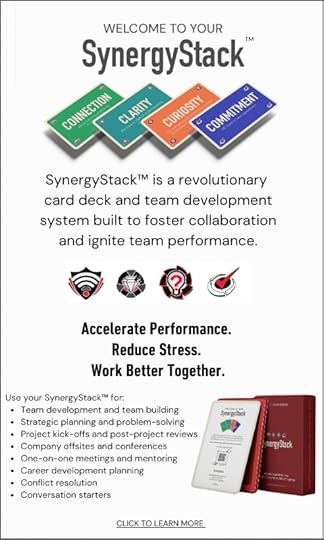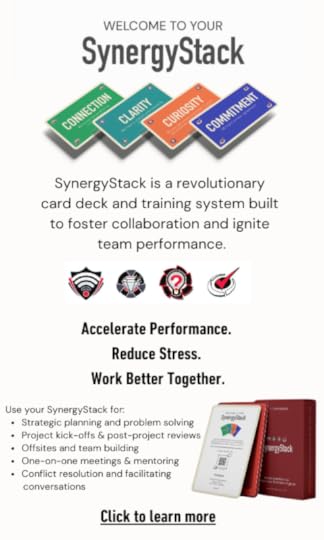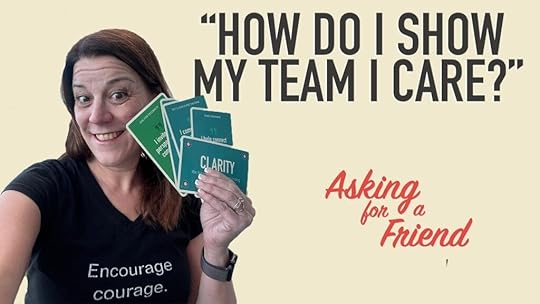David Dye's Blog, page 4
July 18, 2025
Share Your Concerns: Speak Up Without Blowing Things Up
it just delays the meeting about it.
You know that moment. The one where your Spidey senses tingle. Something’s off. The numbers don’t line up, the timeline feels wobbly, or someone’s “great idea” is slowly morphing into a future train wreck. Your gut says, “I should share my concerns,” but my inner voice whispers, “Hmm… maybe stay quiet. This could get awkward.”
But here’s the thing: staying silent doesn’t keep the peace. It just delays the inevitable “I wish someone had said something sooner” meeting. And guess what? You are someone.
That’s where the “share concerns” habit comes in. It’s all about choosing courage over comfort and creating a culture where you can say what’s real—without getting labeled the team killjoy.
How Do I Share My Concerns Without Sounding Like an Idea Crusher?

Watch this Special Asking For a Friend Video Featuring Chad the Curiosity Goat
Let’s start with your go-to, disarmingly honest phrase:“I’m concerned about ___ because…”
That’s it. No need for dramatic music or interpretive dance. Just a calm, precise, truth-telling moment.
What It Means to Share Your ConcernsSharing concerns doesn’t mean launching into a five-minute TED Talk about everything that’s ever gone wrong. It means you speak up—especially when it matters most. (Although we love TED talks as much as you… In fact, you can watch Karin’s TEDx here, on how to surface remarkable ideas you can actually use here)
You say the thing. Raise the flag. Shine the flashlight into the dusty corners before they catch fire.
You’re not waiting for permission or a perfect opening. And you’re definitely not throwing verbal grenades. You speak up with care, clarity, and the intent to help.
Why Sharing Your Concerns MattersThink of this habit as the seatbelt of team communication: not always flashy, but a total lifesaver when things get bumpy.
When you use it:
Small problems stay small.
Others feel safe to chime in too.
“Conflict” becomes “collaboration in progress.”
Feedback doesn’t sting—it strengthens.
This isn’t about being that person. It’s about being the teammate who gives a damn.
Why It’s Hard (and Why You Should Do It Anyway)Sharing your concerns means being vulnerable. You might worry about hurting someone’s feelings, being labeled a downer, or slowing momentum. And if your concern involves someone’s pet project or behavior? Woof. Even tougher.
But here’s the paradox: silence doesn’t protect relationships. It quietly erodes them. Speaking up with respect, on the other hand? That’s how you build trust, clarity, and forward motion.
How to Share Without Sounding Like a ComplainerReady to try? Here’s your Share Concerns starter pack:
Lead with your phrase. “I’m concerned about ___ because…” gets straight to the point and keeps it grounded in impact.
Stick to observations. Say, “I noticed we skipped the stakeholder review,” not “You’re clearly sabotaging the process.”
Frame it as a contribution. Try: “I’m sharing this because I want us to succeed.”
Invite conversation. Ask: “Does this concern make sense? Am I missing something?”
Stay engaged. If your concern leads to change, great. If not, keep showing up—curious, committed, and constructive.
Other Phrases That Keep the Conversation Safe and HonestIf “I’m concerned…” feels too formal, try one of these:
“Something’s not sitting right with me—I’d like to talk it through.”
“Can I raise a flag here?”
“I might be off, but I’m noticing…”
“This could just be me, but I’m seeing a risk in…”
“What’s our plan if ___ goes wrong?”
Sometimes, the phrase is less important than the tone behind it. Curiosity beats certainty every time.
Three Mini-Personal Experiments to Build the HabitTry one of these personal challenges to strengthen your Share Concerns muscle:
1. 30-Day Clarity PracticeEvery time a concern bubbles up (tight chest, rumination loop, vague dread), jot it down. Practice saying it with the phrase: “I’m concerned about ___ because…”
2. Pre-Conversation RehearsalFor two weeks, write your concern out first:
Here’s what I noticed.
Here’s why I’m concerned.
Here’s what I’d like to explore.
Then say it out loud. Bonus: notice how much calmer you sound when you’ve already untangled your thoughts.
3. Concerns = Care ReframeFor 30 days, flip the script. When someone shares a concern with you, treat it like an act of care. Say: “Thanks for raising that.” Watch how the trust grows.
Final WordSharing concerns isn’t about being difficult—it’s about being devoted. To the mission. To the people. And, to getting it right.
When you speak up with clarity and care, you’re not just avoiding disasters. You’re modeling the kind of courage that makes work better for everyone.
And it all starts with:
“I’m concerned about ___ because…”
See Also: How to Stop Being Perceived as Negative at Work
Psychological Safety: Why People Don’t Speak Up at Work
“Share your concerns” is one of the habits in our SynergyStack® Team Development System. Click on the image below to learn more about the SynergyStack System, or contact us to schedule a demo.
The post Share Your Concerns: Speak Up Without Blowing Things Up appeared first on Let's Grow Leaders.
10 Ways Fear Undermines Your Leadership Skills and What to Do to Fight Burnout
Episode 312: What if the secret to becoming a more confident leader and fighting burnout is learning to recognize how fear is running the show?
Fear doesn’t just sit in the background—it hijacks your leadership, clouds your judgment, and quietly fuels burnout. If you’ve ever avoided a tough conversation, felt isolated at the top, or found yourself paralyzed when the stakes are high, this episode is for you. David explains how fear disguises itself as caution, control, and perfectionism—and offers guidance on what to do instead.
In this episode, you’ll discover:
The 10 subtle leadership mistakes fear causes—and how to stop them before they cost you credibility.Simple mindset shifts and behaviors that restore your courage and re-energize your leadership.Practical tools to lead with clarity, stay connected to your team, and stop fear from driving your decisions.Hit play now to break free from fear-based habits and start leading with the confidence that fights burnout and builds lasting influence.
Leading with Fear Is Like Leaving Your Leadership in the Garage[01:44] – The scratched car metaphor: David shares a story about his son witnessing a car door getting dinged, using it to highlight how fear of making mistakes can paralyze your leadership. You can’t protect your leadership from every scratch—if you’re afraid to mess up, you’re not really leading.
[02:44] – Mistake #1 – Avoidance hides the real work: Fear often makes you procrastinate the task that matters most. But that discomfort is actually a signal pointing to your MIT—Most Important Thing.
[04:09] – Mistake #2 – Fear erodes credibility: When you freeze up and don’t communicate, your team notices. They lose trust not because you’re afraid, but because you’re not honest about it.
[05:06] – Mistake #3 – Fear isolates you: Fear makes you feel alone and overwhelmed. But your team is one of your greatest assets. Reconnecting with others gives you strength, perspective, and momentum.
[07:13] – Mistake #5 – Fear halts future-building: Fear doesn’t build—fear dodges. If you’re stuck in “let’s not fail” mode, you can’t inspire your team. To fight burnout and lead well, focus on the real consequences and the future you want to create.
Courageous Leadership That Builds Confidence and Fights Burnout[09:46] – Mistake #7 – You stop taking healthy risks: Playing it safe keeps you stagnant. Growth, confidence, and the ability to fight burnout all rely on staying in learning mode—even when it’s uncomfortable.
[10:51] – Mistake #8 – No apologies, no growth: Fear of appearing weak stops you from owning mistakes. But sincere apologies build trust and model humility, which reduces emotional strain—for you and your team.
[12:47] – Mistake #9 – Victim mindset takes over: Fear leads to helplessness. David offers two empowering questions to shift your mindset and fight burnout: What do I really want to achieve? And what can I do to get there?
[14:35] – Mistake #10 – You spread fear to your team: Leaders recreate themselves. If fear drives your behavior, your team will pick up on it and mirror it—creating a stressed-out, reactive culture.
[15:59] – Fear shrinks with practice: Over time, the things that once caused weeks of anxiety will take just hours of clear thinking. To fight burnout, take small steps toward your fear instead of avoiding it entirely. Start with curiosity and one simple action.
The post 10 Ways Fear Undermines Your Leadership Skills and What to Do to Fight Burnout appeared first on Let's Grow Leaders.
July 14, 2025
Repairing Broken Trust on Your Team: A Leader’s Guide to Rebuilding Collaboration
You can feel it even if no one’s saying it. There’s a weird tension in meetings. People stop making eye contact. Collaboration slows to a crawl. A few folks are “just swamped”—but that’s not the whole story. Repairing broken trust is your new MIT (most important thing).
Something happened. Someone dropped the ball. A decision went sideways. A conversation didn’t land right—or didn’t happen at all.
And now trust has cracked. Maybe even splintered.
Repairing broken trust is vital and fast. So what do you do?
Let’s walk through how to repair trust with clarity and courage.
Get Clear on the BreakdownYou can’t rebuild trust if you don’t know what collapsed.
Ask yourself:
Was this a one-time incident, or is there a pattern?Is trust broken between individuals, or is the whole team impacted?Was this about performance, miscommunication, power, or behavior?Did it involve you directly, or are you supporting others through it?You don’t need perfect information. You need a working understanding of where things veered off track. That’s your starting point.
What to say:
“Let’s name what’s getting in the way of collaboration—so we can work through it together.”
Practical Tip for Repairing Broken Trust:If you’re unsure what’s broken, ask each person a courageous question:
“What’s one thing making it harder to collaborate right now?”
You’ll learn more in those 1:1s than in ten status updates.
Invite “No Diaper Genie” ConversationFirst, if you’re new to Let’s Grow Leaders, here’s what we mean by diaper genie feedback. It means not sugar coating the conversation or disguising the trusth in layers of self protection.
You can open that space using the 4 Cs: Connection, Clarity, Curiosity, and Commitment.
Connection: “I care about this team and how we work together.”Clarity: “Here’s how I understand the breakdown—and I’d like to hear how you see it.”Curiosity: “What’s your take? What’s felt unspoken or unresolved?”Commitment: “Let’s choose one thing we’ll each do to start rebuilding trust.”If the Trust Break Was With YouMaybe it was you who made the call that felt unfair
Or, you missed a desdline and idn’t follow through.
Whatever it was, own it. Quiet regret helps no one. Over-explaining helps even less.
Start by taking responsibility.
“I see how that impacted you. And I want to make this right.”“I’m learning from this situation and here’s what I’m doing differently.”“I don’t expect instant trust—I just want to earn it back.”And then…Makea visible, specific commitment.
“I’m working on listening more, especially when things are tense. Please hold me to that.”
That one sentence might do more to rebuild trust than a perfectly worded apology.
See Also: How to Increase Trust On Your New Team
Create Ongoing Space to RepairTrust is not rebuilt in a single conversation. It is rebuilt through dozens of smaller ones—side chats, honest check-ins, shared wins, and mutual accountability.
Schedule time to revisit how the team works—not just what it produces.
What to ask:
“What’s working better now?”“What’s still a little off?”“What’s one way we can show up better for each other this week?”When the Energy’s Still Heavy…Sometimes you’ll do all the right things… and it still feels stuck.
When that happens, name it.
“I know we’re not back to full trust yet—and I’m not rushing that. I’m here for the long haul.”
🛠 Quick Team Exercise: Repairing Broken Trust TogetherA practical, habit-based reset—powered by Synergystack or sticky notes
💬 Purpose:To reflect on what’s working, name what’s not, and co-create a small shared habit that helps rebuild trust and improve collaboration, without the awkwardness or overprocessing.
⏱️ Time:25–35 minutes
👥 Group Size:4–10 people
(For larger teams, break into small groups and reconvene with themes)
 📋 What You’ll Need:
📋 What You’ll Need:Sticky notes or shared doc
A whiteboard, wall, or shared screen
Optional: Synergystack Card Deck and access to the Synergystack Resource Center
🧭 How It WorksStep 1: Set the Frame (2–3 minutes)Start with clarity and care:
Step 2: Reflect on 3 Questions (5–7 minutes)“I want to take a moment to talk about how we’re working together, not just what we’re working on. We’ve had some friction (or silence, or tension), and this isn’t about blame—it’s about figuring out what helps us collaborate better, starting with what’s already working.”
Ask everyone to write down answers to these on sticky notes or in a shared doc (one note per thought):
What’s working on our team that we can build on?
What’s made collaboration harder than it should be lately?
What’s one habit that would help rebuild trust here?
If You Have the SynergyStack® Deck:Instead of sticky notes, invite each person to:
Choose a card that reflects a team strength habit they’ve noticed (something team members do consistently)
Choose a card that names a trust-building habit that would make the most significant difference if every team member did it consistently.
This makes the conversation easier to start and gives people words they might not find otherwise.
Step 3: Share and Spot the Patterns (10 minutes)Invite sharing (out loud or anonymously), and as a group, cluster common themes:
Speak to patterns, not individuals.
Step 4: Align on One Habit to Try (10 minutes)“Sounds like we’re valuing connection (learning about people, pets, and projects), but we’re struggling with assumptions (check for understanding) and unclear follow-up (commitment habits)”
Ask:
“What’s one habit we can all try this week to strengthen trust?”
Aim for one simple, shared commitment. Some examples:
“Follow through on action items within 48 hours—or say why not.”
“Assume good intent—and ask before reacting.”
“Speak directly, not about someone, when there’s tension.”
Step 5: Wrap With Encouragement (2 minutes)🔄 Ongoing Support“Thanks for doing this. Rebuilding trust isn’t a dramatic gesture—it’s these little agreements we show up for together. Let’s try this habit for a week and check back in.”
You can revisit this habit weekly using:
A check-in: “How’s this showing up for us?”
Team rotation: One person each week leads the habit reflection.
Sharing resource via the Synergystack Resource Center (sample habits, check-in questions, how-to videos)
The post Repairing Broken Trust on Your Team: A Leader’s Guide to Rebuilding Collaboration appeared first on Let's Grow Leaders.
July 11, 2025
How to Improve Your Productivity by Mastering 1 Critical Leadership Communication Skill
Episode 311: Want to master a leadership communication skill that helps you be more productive, avoid overwhelm, without hurting relationships or your reputation?
If you’re feeling overwhelmed by meetings, projects, and endless to-do lists, you’re not alone. This episode dives into one of the most underrated leadership superpowers: saying no. Whether it’s your boss, a colleague, or your own inner voice piling on more than you can handle, mastering the art of a thoughtful no can dramatically reduce stress, sharpen your focus, and elevate your effectiveness.
Here’s what you’ll walk away with from this episode:
Practical, non-confrontational phrases you can use immediately to say no—without guilt or conflict.A powerful framework using the four C’s—connection, clarity, curiosity, and commitment—to guide your no’s with purpose and professionalism.Strategies for saying no to your boss (yes, really!) that actually build trust, respect, and credibility.Press play now to unlock the confidence and language you need to say no with grace—and yes to what truly matters.
Mastering the Leadership Communication Skill of Saying No00:00 – Why Saying No Matters. Host David Dye introduces the episode by framing saying no as an essential leadership communication skill. It reduces overwhelm, improves focus, and boosts your professional reputation.
01:40 – Saying No to Colleagues Without Burning Bridges. Learn how to turn someone down—gracefully—by starting with appreciation and connection. Then offering a respectful and honest “no” that maintains strong relationships.
02:37 – The Four Cs of Effective No. David introduces a powerful framework for saying no: Connection, Clarity, Curiosity, and Commitment—a structure that turns refusals into opportunities for collaboration.
04:42 – Say Yes to Say No. Discover how starting with a “yes” to values, relationships, or intent builds rapport and makes your “no” feel less like rejection and more like a strategic decision.
06:48 – Meetings: A Hidden Drain. Explore ways to gracefully decline meeting invitations by getting clear on the contribution that’s needed—and offering efficient alternatives that protect your time.
Practical Scripts & Confidence for Real-Life Scenarios08:27 – Saying No with Expertise and Confidence. When you have deep knowledge on a topic, use it to assert a “no” while staying open to other perspectives—a true mark of a seasoned communicator and leader.
09:54 – Navigating Ethical Dilemmas with Clarity. Saying no based on values or ethics is one of the simplest and clearest forms of leadership communication skill. Use direct, principle-based language, and invite dialogue when appropriate.
12:28 – The Ultimate Test: Saying No to Your Boss. David shows how to blend all four Cs to push back on a request from your boss—without sounding rebellious or uncommitted. This is high-level leadership communication in action.
14:57 – Turning Conflict into Dialogue. Shift from tension to teamwork by presenting your “no” with empathy, offering alternatives, and asking for input. This builds trust and supports mutual success.
18:24 – Saying No is Saying Yes to What Matters Most. The episode closes by reframing “no” as a way to say yes to priorities, wellness, and team success. It’s not just self-care—it’s a critical leadership communication skill that everyone benefits from.
The post How to Improve Your Productivity by Mastering 1 Critical Leadership Communication Skill appeared first on Let's Grow Leaders.
July 7, 2025
Boost Team Confidence Fast with This Wildly Successful Team Training Activity
Have you ever rolled out a new strategy and watched your team stare back like you suggested they wrestle alligators? You set a clear vision and explained why it matters, and instead of a chorus of “Let’s do this!” you get polite nods and a lot of side-eye. They get it—they’re just not sure they can pull it off. You need to boost team confidence fast. What do you do?
That’s where a Confidence Burst comes in—a wildly successful team training activity that boosts team confidence, creates a ruckus (the good kind), and shows your team what they’re capable of.
Ruckus, Results, Repeat: The Magic of One Wild DayThe magic isn’t just in the ruckus—it’s in focusing on the one habit that makes the biggest difference.
I (Karin) once took over a struggling 2200-person sales team at Verizon. They felt they couldn’t compete because our biggest competitor, AT&T, had an exclusive iPhone deal (I know, it’s been a minute since this was the case, but stay with me, it’s a powerful story). Morale was in the gutter.
Then I met Yomi—a rep who was crushing his numbers. He wasn’t selling iPhones. Or chasing gimmicks. He just asked one powerful question:
“Where do you work?”That question unlocked everything. When he asked “where do you work,?” he found lots of customers who owned small businesses.Yomi targeted small business customers who needed secure, reliable devices and custom solutions—not flashy phones.
Now we needed a wildly successful sales training activity to get everyone jamming with Yomi’s best practice.
So we didn’t just talk about his habit. We celebrated it. We created a ruckus.
Small Business Madness Day: A Tactical Confidence Burst

We launched “Small Business Madness Day.”
BalloonsJust in time trainingPeer-to-Peer CoachingBest Practice SharingCelebrating every time the habit led to a saleHighlighting success storiesExecutives and managers modeling the wayAll about one clear, celebrated habit: Ask every customer, “Where do you work?”We didn’t just recognize sales—we recognized and celebrated the habit.
Result? Our sales quadrupled that random Tuesday. More importantly, the team walked out saying:
“If we can do this for one day, we can do it every day.”
That’s the magic of a Confidence Burst. It’s a fast track to boost team confidence and give them a taste of what’s possible. That team blew away the other regions in sales results that year, and won the President’s award for customer growth.
More stories and tools for discovering micro-innovations like Yomi’s in our book Courageous Cultures (and more on this story in Chapter 6).
Choose Your Game-Changing Habit—Because ‘Do Better’ Isn’t a Strategy.If you want to try this wildly successful training activity with your team, start by asking:
What’s the one habit that could transform results?
Is it clear, simple, and measurable?
How can we make shine a spotlight on this habit with fun and enery?
Tactical Habits (Perfect for Short Bursts)These are fast and direct habits that help isolate a habit you can tie directly to business results.
Sales: “Ask every customer, ‘Where do you work?’” (or other probe to uncover key insights)
Process Improvement for a laboratory “Save unused reagents to avoid waste.”
Contact Centers: “Create empathy in the first 40 seconds of every call.”
Productivity: “Prioritize the most critical tasks before noon.”
Collaboration Habits That Drive ResultsBecause these habits appear in everyday interactions, you’ll need a longer burst– to ensure enough opportunties to apply and celebrate the habit
Here are a few collaboration habits from our SynergyStack® Team Development System.
Active Listening: “I give you my full attention and respond thoughtfully.”
Celebrate Wins: “I generously acknowledge others’ contributions.”
Define Success: “We establish clear outcomes and expectations.”Check for Understanding: “I ensure the message sent is the message received.”
Schedule the Finish: “We always agree on who’s doing what by when.”
Clarify Ownership: “I ensure everyone knows who is responsible for what.”
How to Boost Team Confidence With Your Own Confidence Burst Team Training Activity1. Pick Your Game-Changing HabitsChoose one or two habits that will make the biggest difference (think: small change, big impact).
2. Build Buzz Like It’s a Rock ConcertSet the date, tease it like an epic event, and let your team know something exciting is coming.
3. Kick Off with Energy (Think Holiday Vibes)Start with music, snacks, or even a funny kickoff speech. Make it feel different—like a celebration, not just another day.
4. Set Crystal-Clear GoalsGive your team a simple, measurable target they can crush by the end of the day.
6. Quick-Hit Training (No Snoozefest Allowed)Offer a fast, focused training session so everyone knows what success looks like.
7. Pair Pros with LearnersYour team members who rock the skill should work alongside those still learning—instant coaching and confidence.
8. Celebrate Every Little Win (Loudly)Got a success story? Shout it out. High-fives, cheers, and spotlight moments make success contagious.
9. Share the Stories Behind the WinsDon’t just celebrate—explain the “how” so everyone learns what works.
10. Debrief Like a Winning Locker RoomWrap up the day with a quick chat—what worked, what surprised you, and what you learned.
11. Don’t Lose Momentum:Start the next day with a quick recap—keep the best lessons alive.
Want so help with your ruckus? Transform Your Team with the SynergyStack® Team Development System or a SynergySprint Team RetreatReady to elevate your team’s performance? Explore our SynergyStack® Team Deveiopment System to help your team identify key habits and leverage proven collaboration strategies.
Want fast, focused improvement? Let’s talk about designing a SynergySprint Team Retreat for your team. Contact us at info@letsgrowleaders.com
The post Boost Team Confidence Fast with This Wildly Successful Team Training Activity appeared first on Let's Grow Leaders.
July 4, 2025
4 Leadership Assumptions that Limit Your Team’s Productivity
Episode 310: Which leadership assumptions are quietly sabotaging your team—and what if you don’t even know you’re making them?
If you’ve ever felt stuck in your role—spending too much time on the wrong problems, struggling to connect with your team, or unsure how to level up your influence—this episode is a must. You’ll learn how the stories you tell yourself shape your leadership and how to rewrite them for better results. In this conversation with coach and author Sean Glaze, you’ll discover:
The four most common leadership assumptions and how they silently hold you back.
A clear, relatable model for moving from confusion to clarity—from unaware to solutions.
How to build a culture that values feedback, clarity, and courageous conversations (without becoming the “nice but ineffective” boss).
Tune in now to learn how questioning your assumptions can unlock greater confidence, impact, and performance in your leadership journey.
The Leadership Assumptions Holding You Back[03:24] – The Awareness Ladder
Sean introduces the four-tier ladder leaders must climb: from being unaware of a problem to identifying symptoms, diagnosing the real issue, and finally reaching actionable solutions.
[07:26] – Four Leadership Assumptions That Derail Success
Sean lays out the four key leadership assumptions that leaders must examine: purpose, principles, people, and politeness, and how these unconscious beliefs can sabotage results if left unchallenged.
[08:37] – Redefining Your Role: The Purpose Trap
Many leaders make the dangerous assumption that their job is still about individual performance. Sean explains how redefining “success” as working through others can dramatically shift your impact.
[12:53] – Principal Assumptions and Culture Clarity
Assuming your team shares your values is a leadership blind spot. Sean shows how defining and demonstrating values behaviorally—not just listing them—creates trust and accountability.
[19:29] – What Story Are You Telling Yourself About Your People?
Leaders often create false narratives based on limited behavior. Sean encourages curiosity over criticism, turning unhelpful assumptions into opportunities for deeper understanding.
Practical Shifts to Strengthen Leadership[23:34] – Niceness vs. Politeness: The Truth About Conflict
Politeness isn’t about avoiding tension—it’s about having hard conversations with care. Sean challenges the assumption that “no conflict” means “healthy culture.”
[26:50] – Stretching the Team (Literally): A Story of Accountability
Sean and David discuss a powerful example from the Denver Nuggets that illustrates how respectful accountability can transform team habits.
[29:42] – Why the Best Teams Have More Conflict
Research shows high-performing teams don’t avoid conflict—they embrace it. Discover how honest conversations foster alignment and drive performance.
[30:55] – Leadership Assumptions Recap: Your 4-Part Checklist
David recaps the four leadership assumptions every leader must challenge to lead more effectively—purpose, principles, people, and politeness—and how to start examining them today.
[31:57] – Reflection or Feedback: Two Ways to Grow Awareness
Sean closes with a simple truth: leadership growth comes from either reflection or feedback. When in doubt, ask better questions and listen more.
About Sean GlazeAs a workplace culture and leadership speaker for over 15 years, Sean has been customizing event experiences to help leaders build “Sticky Cultures”. As a team-building facilitator and teamwork speaker, he has found that most organizations struggle with one of four areas of culture:
1 – Do You Wish Your Employees Were More Like Winning Teammates?
2 – Are You Frustrated by People Who Are Just Not Staying Coachable?
3 – Would Your Managers Benefit From Becoming More Effective Leaders?
4 – Have You Struggled to Discover What Really Drives GREAT Teamwork?
Those areas are the four areas he focuses on to build STICKY CULTURES!
The post 4 Leadership Assumptions that Limit Your Team’s Productivity appeared first on Let's Grow Leaders.
July 2, 2025
How to Lead with Their Best Interest at Heart (Even When It’s Hard)
It’s one of the most reassuring phrases you can say to someone—especially at work, “I’ve got your best interest at heart.”
Said sincerely, it can be comforting, encouraging, even inspiring.
Said poorly, it can come off like, “This is for your own good,” right before handing someone a project they’ll absolutely loathe.
The phrase might be well-meaning, but it begs the real question:
Do they feel it? Do your actions prove it?
Because it’s one thing to say you have someone’s best interest at heart—and another thing entirely to show them.
A Candid Conversation and a Powerful QuestionI was recently talking with a leader who had just completed one of our executive development programs. He shared how he’d been reflecting on the phrase and realized: he wasn’t always sure his team felt it—no matter how often he said it.
So, we tried an experiment together. It was simple, powerful, and I liked it so much, I’m planning to use it with my own team.
Here’s what we did:
He named each of his direct reports, one by one. And for each name, he paused and asked himself:
“What would it look like to really show up with this person’s best interest at heart?”
What followed was eye-opening. Because each answer was completely different.
When It Comes to “Best Interest At Heart,” Not One-Size-Fits-AllFor one team member—a high-potential middle manager—it meant, taking their idea seriously. Not just nodding along in a meeting, but digging into it, helping pressure-test it, offering coaching, and becoming a behind-the-scenes champion for their success.
For another—someone whose recent behavior had been… let’s just say, not exactly career-boosting—it meant having a hard conversation. The kind of honest talk that says, “Hey, I care about you enough to tell you the truth—even when it’s uncomfortable.”
And that’s the heart of it, isn’t it?
What’s in someone’s best interest isn’t always what’s easiest. Or what makes them like you more in the moment. Sometimes, the most caring thing you can do is to tell them what no one else will—or to cheer so loudly they start to believe in themselves again.
Practical Ways to Show You Care
Click here to watch the Asking for a Friend Video
So how do you consistently show your team you’ve got their best interest at heart?
Try weaving in a few of these habits:
Put the laptop lid down. Mute the notifications. Be fully present. Listen like what they’re saying matters—because it does.
Connect with EmpathyThat doesn’t mean being soft. It means showing people: “I care about you. I see you. I’m here with you.” Bonus points if you don’t interrupt.
 Change Your Mind
Change Your MindBe open to new perspectives. Invite people to influence your thinking. “Help me see what I might be missing,” is one of the most powerful trust-building questions out there.
Understand the Impact?Ask it. Mean it. Especially when you’re making a decision that affects them. Understanding the ripple effects shows you’re not just leading from a spreadsheet.
Speak with CandorTruth + grace = growth. Don’t hold back on the truth because you care—share it because you care.
Do What You SayIntegrity 101. When your actions match your words, people know they can count on you. And nothing says “I’ve got your back” like showing up—reliably.
When you tell someone you have their best interest at heart, they shouldn’t have to wonder if it’s true. They should feel it—in your actions, in your consistency, in the way the way you advocate for them, develop them, and tell them truth.
Are you looking for more practical ways to take your human-centeredd leadership to the next level? We can help. Contact us to find a time to learn more.
See Also:
The Secret to Giving Better Feedback (Video)
How to Increase Trust in Your Remote Team
The post How to Lead with Their Best Interest at Heart (Even When It’s Hard) appeared first on Let's Grow Leaders.
June 30, 2025
Quick Decisions: How to Collaborate When You Have to Decide Fast
You’ve got 20 minutes and you need to make a few quick decisions. There’s no time to wrangle a cross-functional roundtable or schedule a “quick” sync (you know, the kind that somehow lasts 47 minutes).
So you do what most people do—you trust your gut, make the call, and brace for the fallout.
But here’s the thing: fast decisions don’t have to mean solo decisions. There’s a better way.
You can collaborate—even in crunch time—without slowing down.
Fast Collaboration Starts with One Thought: “Who else matters here?”You don’t need to invite everyone.
You do need a pulse check from the people:
Who are most affected
Who will help execute
Who might derail you if they’re caught off guard
Think of it like collaboration triage: the goal is connection, not consensus.
And that doesn’t require a meeting. It just takes intention.
Try This: The Two-Minute TouchpointBefore you press “go,” pause and reach out to one or two people with a quick, targeted ask.
Text. Ping. Duck into their office (or virtual chat). Keep it short. And be crystal clear on the input you need for your quick decisions.
Power phrase:
“Hey—gut check. I’m leaning toward [X] because [brief reason]. Any red flags I should know about?”
You’re signaling respect, staying efficient, and avoiding the dreaded “Wait—why wasn’t I included?” moment later.
We’ve seen teams use this approach in high-pressure environments—IT escalations, operations workarounds, sales responses—and gain not just better decisions, but stronger relationships.
Ask for Contribution, Not ConsensusWhen time is tight, you’re not asking for approval. You’re asking for insight.
This one mindset shift can save you hours of cleanup later.
Try questions like:
“What am I not seeing?”
“If you were me, what would you watch out for?”
“What’s one thing you’d do differently here?”
And remember: just because someone’s quiet doesn’t mean they agree. Passive silence is not active alignment.
Bonus: Use the Let’s Grow Leaders Rapid Collaboration Checklist as a Speed FilterPro tip: If you’re not familiar with this team collaboration checklist, we wrote about it here, with a handy chart too. It’s a powerful tool for slowing your thinking just enough to make faster, better decisions—with others, not around them.
You don’t need a full meeting to use it.
Run them through your head like a mental pre-flight checklist:
What do I know?Who needs to know?Do they know?Who does this affect?What do I need to learn?Even running through this mentally in under two minutes can make your decision smarter, faster, and more inclusive.
When it Comes to Quick Decisions, Speed ≠ SilenceYou might think moving fast means skipping the conversation. But not saying something is still a choice—and often a loud one.
If someone hears about your decision third-hand, after the fact, their trust takes a hit—even if your choice was the right one.
When people are left out of the loop, they don’t feel lucky.
They feel dismissed.
So if you want people on board with you later, take 30 seconds now as you make your quick decision.
Make the Call—Then Close the LoopOnce you’ve checked your blind spots, make the call confidently. Don’t wait for full consensus. But don’t ghost your collaborators, either.
Let people know:
What you decided.
Why you moved fast.
When you’ll revisit the outcome.
Power phrase:
“Thanks for the quick input. I made the call to [X] based on what we know. Let’s regroup in a day or two to see how it’s going.”
This is how you build momentum without resentment.
Fast doesn’t mean frantic.
And collaboration doesn’t mean slow.
It means asking the right people the right questions—briefly, clearly, and on purpose.
So next time urgency strikes, don’t fly solo.
Take a beat. Use your filter. Make a better decision—fast.
Your turn. What advice do you have on how to collaborate when time is tight?
See Also: Left Out of the Loop? Here’s How to Step Back in with Confidence
The post Quick Decisions: How to Collaborate When You Have to Decide Fast appeared first on Let's Grow Leaders.
June 28, 2025
Beyond Checking the Box: Show Your Team What Success Looks Like
So, you’ve done the work. You’ve identified the habits that matter most—the practical, tactical behaviors that, when done well, drive the results your team is here to achieve. You’ve communicated them. Maybe even created a job aid or a snappy acronym. And now? Some of your team members are just checking the box.
They’re technically “doing the thing”… but not really doing the thing.
You know what I mean. They’re checking the box. Going through the motions. Phoning it in. And not even with great reception.
They say, “Yeah, I’m doing it,” but you can practically hear the unspoken:
“…and see? It doesn’t work.”
Let’s talk about that.

Watch this, “Asking for a Friend” here
Step 1: Double Down on Clarity
Yes, again. Yes, even if you swear you were already clear.
This time, go beyond simply defining the habit. Instead:
Connect the dots to the bigger picture. Show how this habit impacts actual business outcomes. That might mean doing a little digging—who’s doing the habit well, and what results are they seeing? If their customer satisfaction scores, sales numbers, or productivity metrics are higher, use that. Draw the line. Make it real.
Break down what “good” looks like. Get specific. Don’t assume everyone shares your mental image of excellence. Illustrate it. Tell a story. Use examples. Better yet, use real success stories from your team.
And yes, use your 5×5. That means communicate the expectation five times, five different ways. Email, team meeting, Slack, one-on-one, interpretive dance… okay, maybe not that last one. But the point is: repetition and variety matter.
Include a check for understanding. “Does that make sense?” won’t cut it. Ask them to explain it back to you. Even better—have them show you what great looks like.
Step 2: Show Up CuriousNow that you’ve reinforced what “good” really means, it’s time to dig into what’s getting in the way.
And no, not with an eye-roll or a sigh. With curiosity.
Ask:
What’s hard?
What’s getting in the way?
What’s slowing you down?
What would make this easier?
Is this a skills issue, a tools issue, or something else entirely?
Because checking the box isn’t usually about laziness—it’s often about uncertainty, disconnection, or quiet frustration.
Maybe they tried once and felt it didn’t work. Or were they’re afraid to ask for help. Maybe they think no one’s noticing either way.
Your curiosity can surface all of that. And once it’s out in the open? You can do something about it.
See Also: How to Support a Struggling Sales Person
Step 3: Stay ConnectedThis part matters just as much as the first two.
Once you’ve clarified and explored the obstacles, keep the connection going. Ask:
“What do you need next?”
“What support would make the biggest difference right now?”
“What would success feel like—for you?”
And listen. Really listen.
That ongoing loop of feedback and support helps people re-engage. It signals, “I see you. I want you to succeed. And we’re in this together.”
What Would You Add? How do you help your team move from “checking the box” to spending their time on what matters most?When your team is phoning it in, it’s tempting to dial up the pressure. But real results don’t come from more rules or heavier oversight. They come from going back to the basics—with more intention:
Clarity. Curiosity. Connection.
These are your leadership power tools. And when you use them well? You don’t just get compliance. You get commitment.
And that’s when the magic happens—when the habits you know will work actually start working, because they’re being done with heart, purpose, and skill.
So… what would you add?
What’s worked for you when your team’s technically on board, but not really all in?
The post Beyond Checking the Box: Show Your Team What Success Looks Like appeared first on Let's Grow Leaders.
June 27, 2025
The Surprising Communication Skill Undermining Your Team’s Productivity
Episode 309: Could a surprising communication skill be the hidden reason your hard-working team still struggles with productivity?
You’re not imagining it. The real culprit behind missed deadlines, communication breakdowns, and lackluster performance often comes down to one overlooked issue: unclear expectations. In this episode of Leadership Without Losing Your Soul, you’ll learn how mastering just one leadership skill—clarity—can instantly shift your team from confusion to momentum.
Here’s what you’ll take away from this episode:
Simple, actionable habits to clarify expectations and eliminate the frustration of “Why didn’t they do that?”
A smarter approach to communication that turns meetings and one-on-ones into alignment powerhouses.
Pro-level leadership practices that help you uncover blind spots and drive better team results—with less stress.
Tune in now and discover how a few clarity habits can transform your team’s productivity and your own leadership impact—starting today.
Why Productivity Breaks Down at Work00:57 – Most team conflicts and underperformance stem from one source: violated or unspoken expectations. This sets the stage for understanding the deeper issue behind productivity gaps.
01:44 – The core of many leadership and productivity struggles is misaligned expectations—a surprising communication skill you may not realize you’re neglecting is the ability to define and communicate those expectations clearly.
04:03 – Begin solving the problem by clearly establishing outcomes and expectations, ensuring everyone understands what success looks like from the outset.
04:53 – Leaders must uncover and communicate the “why” behind every task. Without this connection to purpose, team motivation and clarity quickly fade.
06:28 – Don’t stop at knowing the “why”—take the extra step to connect daily work to the bigger picture, helping your team understand their role in a meaningful way.
Mastering the Surprising Communication Skill of Clarity07:36 – Clear expectations aren’t enough—you also need to communicate them consistently. The 5×5 method (five times, five ways) ensures your message sticks.
08:43 – The surprising communication skill of checking for understanding is introduced. This feedback loop is crucial in ensuring your message is effectively conveyed.
10:23 – Schedule “the finish.” Set clear follow-up timelines and confirm priorities. Productivity suffers when follow-through isn’t explicitly planned.
12:05 – Prioritize what matters most. Even if everything feels urgent, a leader’s job is to make trade-offs and help the team focus on what truly drives results.
14:33 – One final surprising communication skill: seek out and clarify others’ interests. When you align individual motivations with team outcomes, collaboration gets a massive boost.
The post The Surprising Communication Skill Undermining Your Team’s Productivity appeared first on Let's Grow Leaders.






